PONTIAC PONTIAC 1996 Workshop Manual
Manufacturer: PONTIAC, Model Year: 1996, Model line: PONTIAC, Model: PONTIAC PONTIAC 1996Pages: 370, PDF Size: 17.69 MB
Page 51 of 370
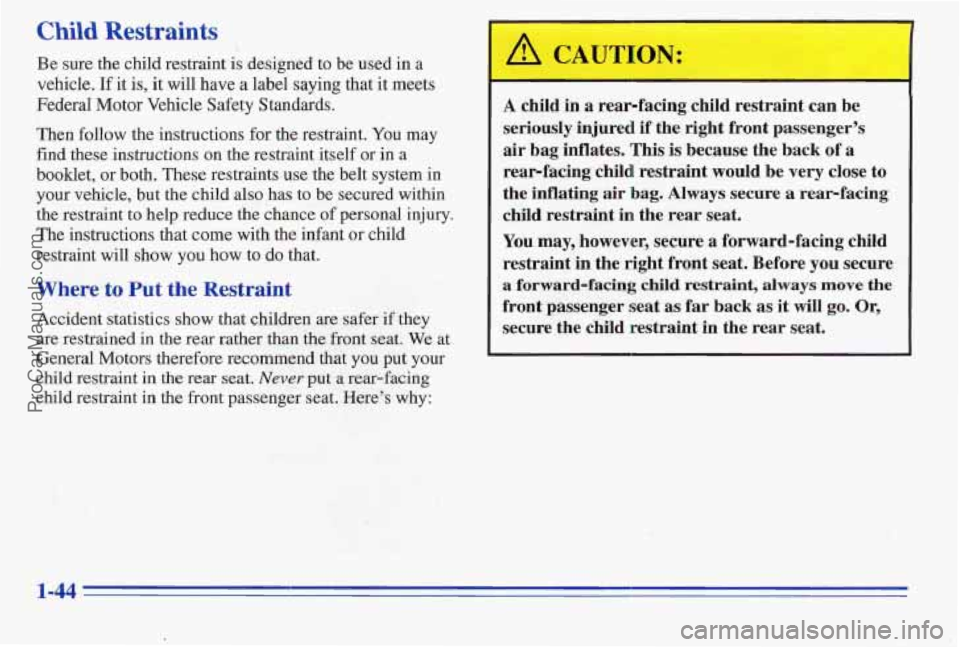
Child Restraints
be sure the child restraint is designed to be used in a
vehicle. If it is, it will have a label saying that it meets
FederaI Motor Vehicle Safety Standards.
Then follow the instructions for the restraint. You may
find these
instructions on the restraint itself or in a
booklet,
or both. These restraints use the belt system in
your vehicle, but the child
also has to be secured within
the restraint to help reduce the chance ofpersonal injury.
The instructions that come with
the infant or child
restraint will show
you how to do that.
L here to :ut the Restrad
Accident statistics show that children are safer if they
are restrained
in the rear rather thanhe front seat. We at
General Motors therefore recommend that you put your
child restraint in
the rear seat. Never put a rear-facing
child restraint in the front passenger seat. Here’s
why:
/! CAUTION:
A child in a rearfacing child restraint can be
seriously injured if the right front passenger’s
air bag inflates.
This is because the back of a
rearfacing child restraint would be very close to
the inflating air bag.
Always secure a rearfacing
child restraint in the rear seat.
You may, however, secure a forward-facing child
restraint
in the right front seat. Before you secure
a forward-facing child restraint, always move the
front passenger seat as far back as it will go. Or,
secure
the child restraint in the rear seat.
ProCarManuals.com
Page 52 of 370
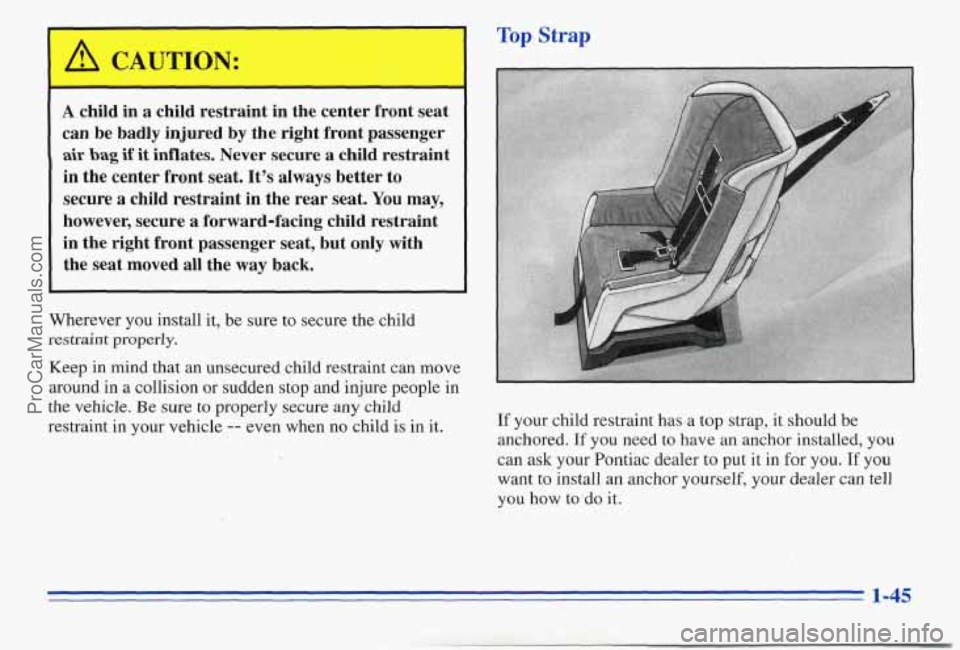
A child in a child restraint in the center front seat
can be badly injured by the right front passenger
air bag if it inflates. Never secure a child restraint
in the center front seat.
It's always better to
secure
a child restraint in the rear seat. You may,
however, secure a forward-facing child restraint
in the right front passenger seat, but only with
the seat moved all the way back.
Wherever you install it, be sure to secure the child
restraint properly.
Keep in mind that an unsecured child restraint can move
around in a collision or sudden stop and injure people in
the vehicle. Be sure
to properly secure any child
restraint
in your vehicle -- even when no child is in it.
Top Strap
If your child restraint has a top strap, it should be
anchored.
If you need to have an anchor installed, you
can
ask your Pontiac dealer to put it in for you. If you
want to install an anchor yourself, your dealer can tell
you how to '-do
it.
1-45
ProCarManuals.com
Page 53 of 370
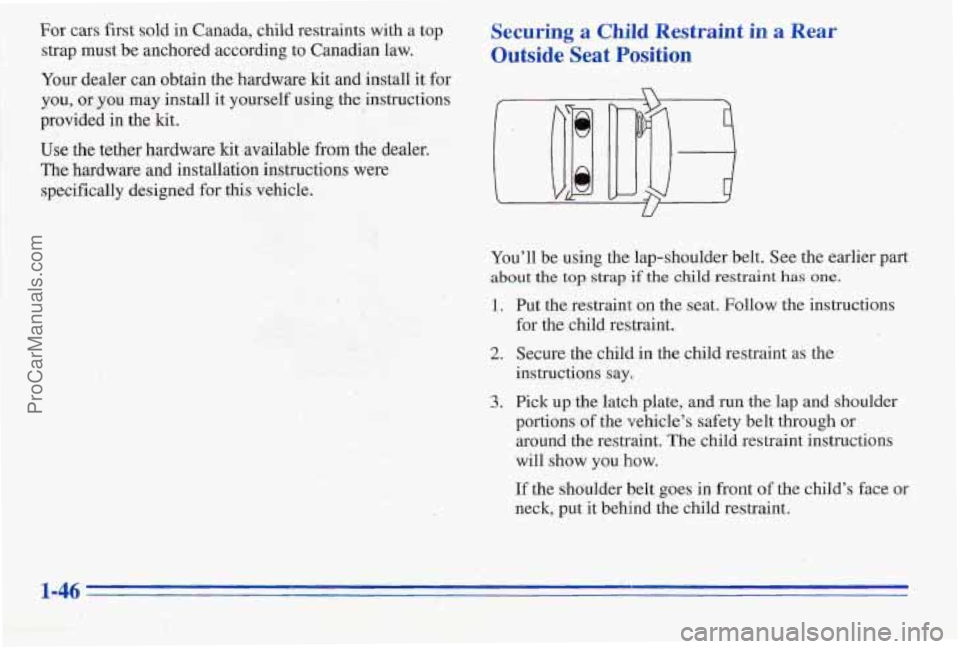
For cars first sold in Canada, child restraints with a top Securing a Child Restraint in a Rear
strap must be anchored according to Canadian law. Outside Seat Position
Your dealer can obtain the hardware kit and install it for
you, or you may install it yourself using the instructions
provided in the kit.
Use the tether hardware kit available from the dealer.
The hardware and installation instructions were
specifically designed for this vehicle.
t
You'll be using the lap-shoulder belt. See the earlier part
about the top strap if the child restraint has one.
1. Put the restraint on the seat. Follow the instructions
for the child restraint.
&
.- .. . .- i
2. Secure-the child in the child restraint as the
instructions say.
3. Pick up the latch plate, ad fun the lap and shoulder
portions
of the vehicle's safety belt through or
around the restraint. The child restraint instructions
will
show you how.
If the shoulder belt goes in front of the child's face or
qeck, put it behind the child restraint.
ProCarManuals.com
Page 54 of 370
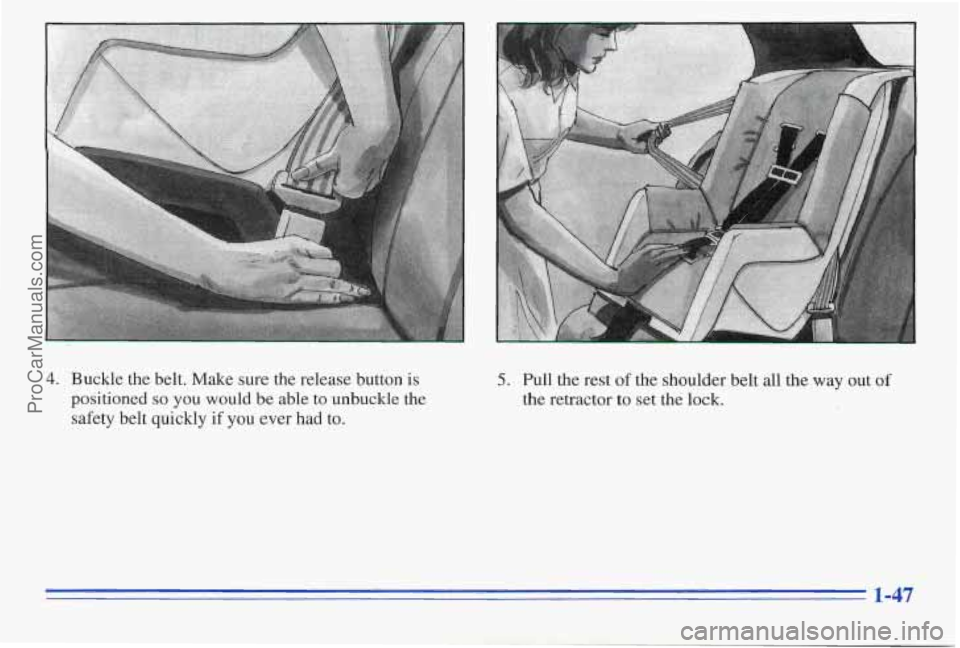
4. Buckle the belt. Make sure the release button is
positioned
so you would be able to unbuckle the
safety belt quickly if you ever had to.
5. Pull the rest of the shoulder belt all the way out of
the retractor to set the lock.
1-47
ProCarManuals.com
Page 55 of 370
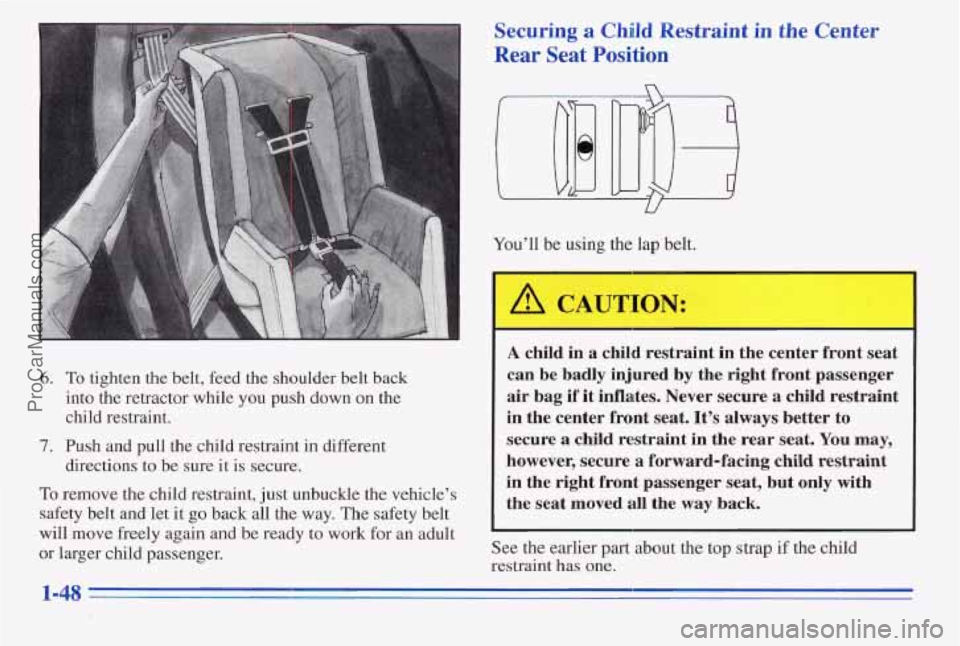
r
6. To tighten the belt, feed the shoulder belt back
into the retractor while you push down
on the
child restraint.
7. Push and pull the child restraint in different
To remove the child restraint, just unbuckle the vehicle’s
safety belt and let it
go back all the way. The safety belt
will
move freely again and be ready to work for an adult
or larger child passenger. directions
to be sure it is secure.
Securing a Ch. testraint in the Cen
Rear Seat Position
You’ll be using the lap belt.
I A CAUTION:
A child in a child restraint in the center front seat
can be badly injured
by the right front passenger
air bag if it inflates. Never secure a child restraint
in the center front seat. It’s always better to
secure
a child restraint in the rear seat. You may,
however, secure a forward-facing child restraint
in the right front passenger seat, but
only with
the seat
moved all the way back.
See the earlier part about the top strap if the child
restraint has
one.
ProCarManuals.com
Page 56 of 370
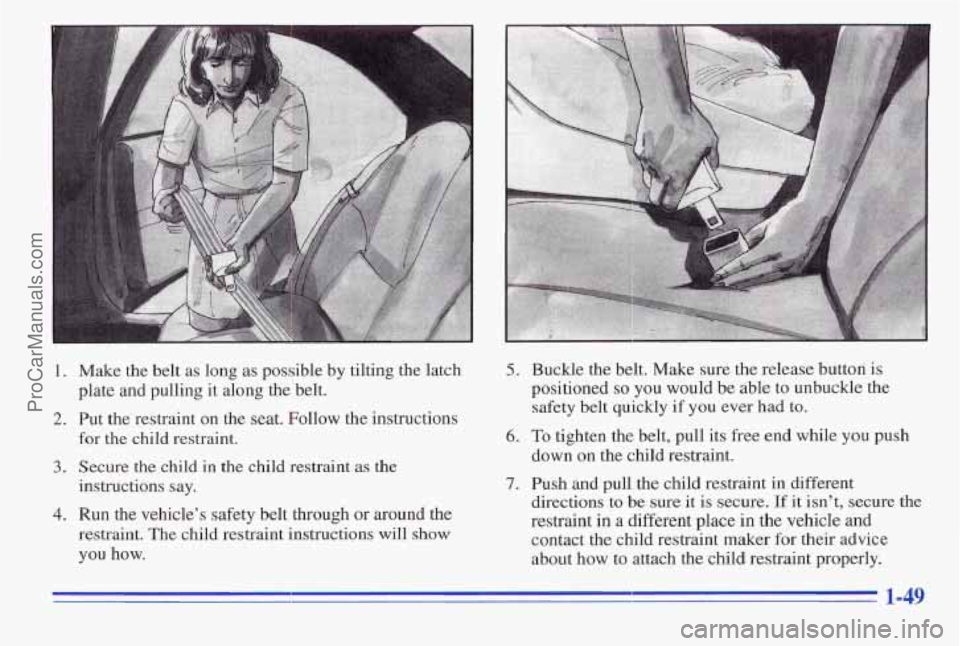
I
1. Make the belt as long as possible by tilting the latch
plate and pulling it along the’belt.
2. Put the restraint on the seat. Follow the instructions
for
the child restraint.
3. Secure the child in the child restraint as the
instructions say.
4. Run the vehicle’s safety belt through or around the
restraint. The child restraint instructions will
show
you how.
5. Buckle the belt. Make sure the release button is
positioned so you would be able to unbuckle the
safety
belt quickly if you ever had to.
6. To tighten the belt, pull its free end while you push
7. Push and pull the child restraint in Merent
down on the child restmint.
directions to be sure it is secure. If it isn’t, secure the
restraint in a different place in the vehcle and
contact the child restraint maker for their advice
about
how to attach the child restraint properly.
1-49
ProCarManuals.com
Page 57 of 370
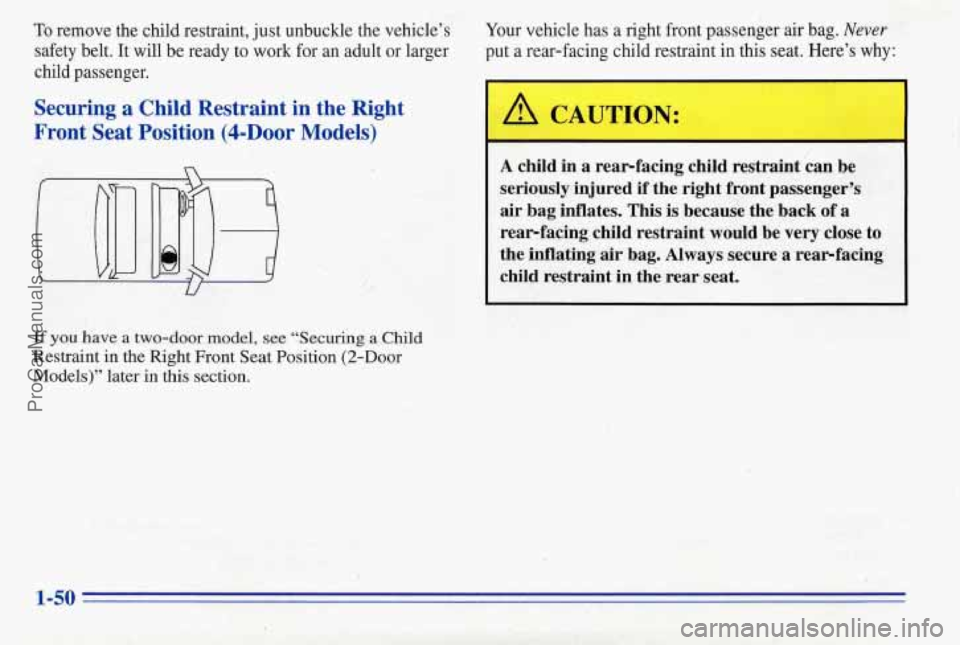
To remove the child restraint, just unbuckle the vehicle’s
safety belt. It will be ready to
work for an adult or larger
child passenger.
Securing a Child Restraint in the Right
Front
Seat Position (4-Door Models)
.. , ,.J!E, , - - , ’ : , . ”. , ., I’ ; . .- .:, I.... i ;L’ .rs
Your vehicle has a right front passenger air bag. Never
put a rear-facing chdd restraint in this seat. Here’s why:
I A CAUTION:
A child in a rearfacing child restraint can be
seriously injured if the right front passenger’s
air bag inflates.
This is because the back of a
rearfacing child restraint would be very close to
the inflating
air bag. Always secure a rearfacing
child restraint in the rear seat.
If you have a two-door model, see “Securing a Child
Restraint in the Right Front Seat Position (2-Door
Models)” later in this section.
1-50
~ I
ProCarManuals.com
Page 58 of 370
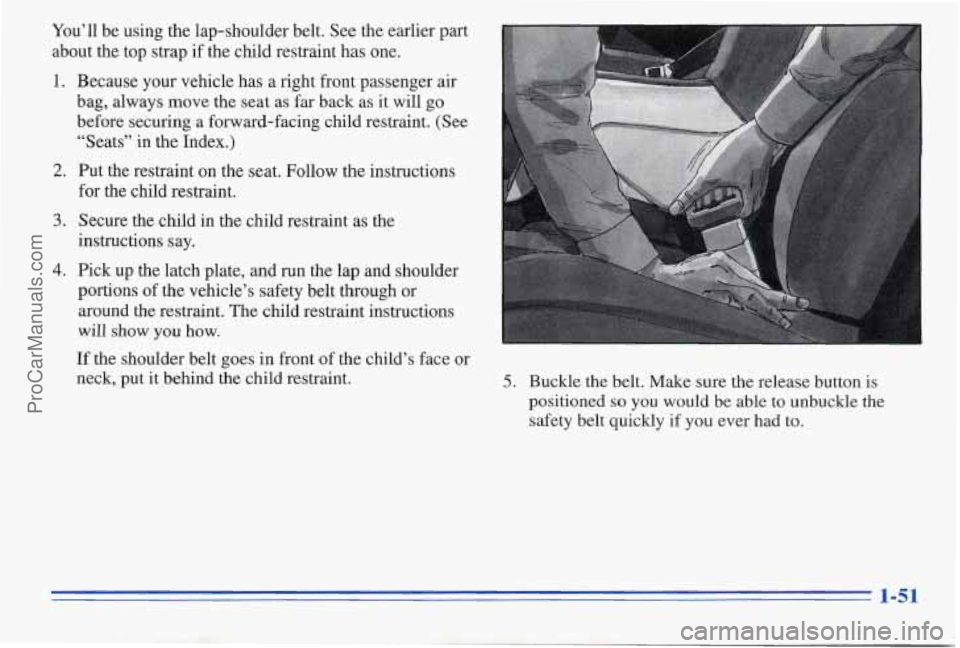
You’ll be using the lap-shoulder belt. See the earlier part
about the top strap if the child restraint has one.
1. Because your vehicle has a right front passenger air
bag, always move the seat as far back as it will
go
2.
3.
4.
before securing a forward-facing child restraint. (See
“Seats” in the Index.)
Put the restraint on the seat. Follow the instructions
for the child restraint.
Secure the child in the child restraint as the
instructions say.
Pick up the latch plate, and run the lap and shoulder
portions of the vehicle’s safety belt through or
around the restraint. The child restraint instructions
will show
you how.
If the shoulder belt goes in front of the child’s face or
neck, put
it behind the child restraint. 5. Buckle the belt. Make sure the release button is
positioned
so you would be able to unbuckle the
safety belt quickly if you ever, had to.
1-51
ProCarManuals.com
Page 59 of 370
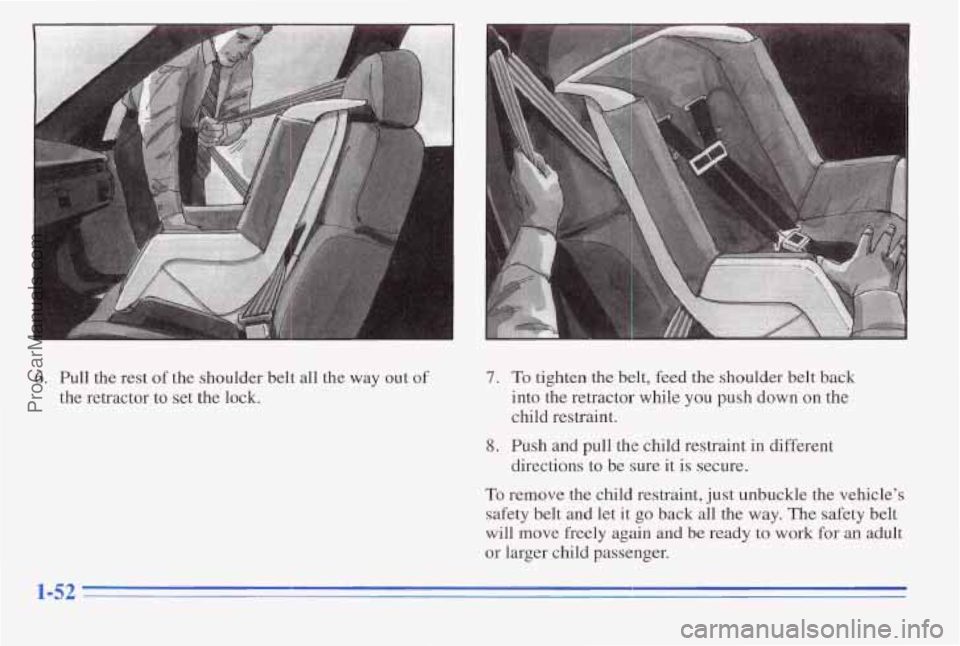
6. Pull the rest of the shoulder belt all the way out of
the retractor to set the lock.
7. To tighten the belt, feed the shoulder belt back
into the retractor while
you push down on the
child restraint.
8. Push and pull the child restraint in different
directions to be sure it is secure.
To remove the child restraint, just unbuckle the vehicle’s
safety belt and let it
go back all the way. The safety belt
will move freely
again and be ready to work for an adult
or larger child passenger.
ProCarManuals.com
Page 60 of 370
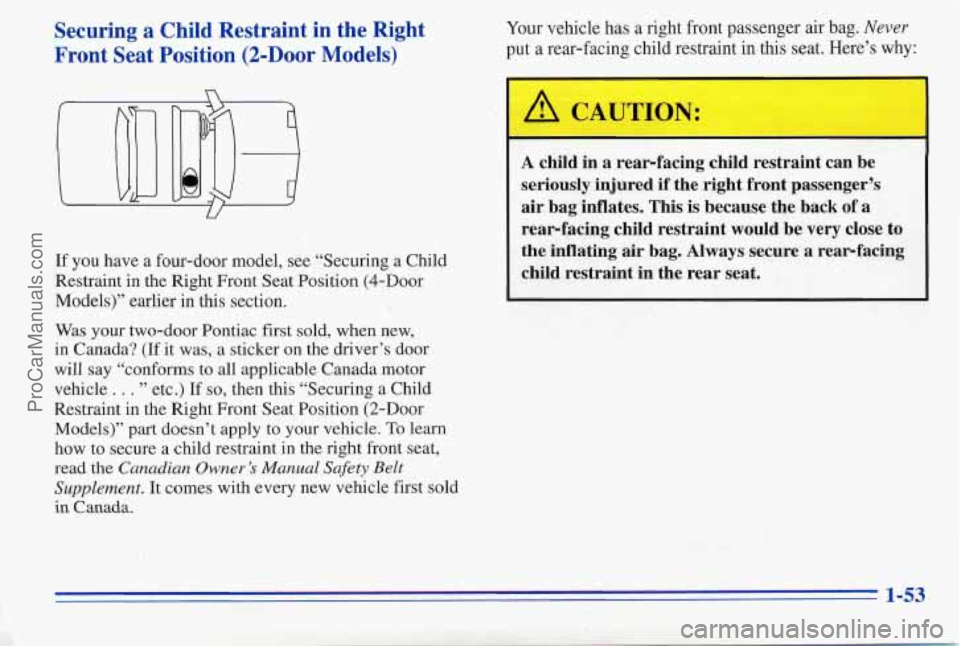
Securing a Child Restraint in the Right
Front Seat Position
(2-Door Models)
Your vehicle has a right front passenger air bag. Never
put a rear-facing child restraint in this seat. Here’s why:
A C TION:
A child in a rearfacing child restraint can be
seriously injured
if the right front passenger’s
air bag inflates. This is because the back of a
. -. S,’, ;..’: . , 8, : , ‘ ,” -._ a .
~, . . I .- I ., ~ . I ., .?. - , ,.
I . I , Q I- .~ . . .#. .. . .. .. rear-facing child restraint would be very close to - . . .. . . .. 1 I<..., , I. ” ‘1 4,., ,e’-. , I
If you have a four-door model, see “Securing a Child
Restraint in the Right Front Seat Position (4-DOOr
Models)” earlier in this section.
Was your two-door Pontiac first sold, when new,
in Canada?
(If it was, a sticker on the driver’s door
will say “conforms to all applicable Canada motor
vehicle
. . . ” etc.) If so, then this “Securing a Child
Restraint in the Right Front Seat Position (2-Door
Models)” part doesn’t apply to your vehicle.
To learn
how to secure
a child restraint in the right front seat,
read
the Canadian Owner’s Manual Safety Belt
Supplement. It comes with every new vehicle first sold
incanada.
the inflating air bag. Always secure a rearfacing
child restraint in the rear seat.
1-53
ProCarManuals.com